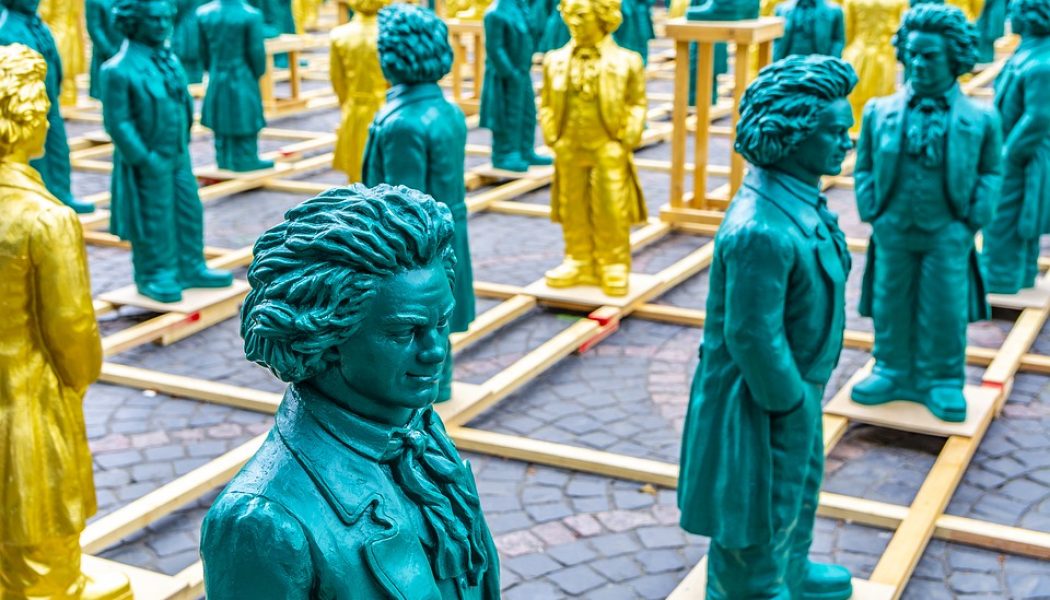Please enjoy this symposium on the nine symphonies of Ludwig van Beethoven, with contributions from our distinguished panel, including composer Michael Kurek and Principal Trumpet of the Baltimore Symphony Orchestra, Andrew Balio. Clicking on the CD cover art next to each symphony will guide you to a listening recommendation on Spotify; at the bottom of the essay is a link to the complete playlist on Spotify of these recordings (subscription required).
 First Symphony in C major, Op. 21 (premiered 1800) — by Stephen Klugewicz, Editor of The Imaginative Conservative
First Symphony in C major, Op. 21 (premiered 1800) — by Stephen Klugewicz, Editor of The Imaginative Conservative
Beethoven did not embark on writing a symphony until he was 29 years old, when he was still known primarily as a great piano virtuoso who also composed. Though he would achieve immortality in this genre, to contemporary audiences the First would not have sounded like a radical break with the symphonies of Mozart and Haydn, in whose shadow Beethoven was clearly working. Indeed, Hector Berlioz said of the First Symphony: “This is not Beethoven. We are about to meet him.”
Yes, the First Symphony runs a modest, classical length—about 25 minutes—and contains the typical four movements of the classical symphony, in the prescribed formula. Set in the key of C major, it is bright, musical, and generally untroubled. Yet there are those Beethovenian touches everywhere: At the very opening of the piece, for example, Beethoven teases his audience by having an uncertain, quiet exchange among the woodwinds, with plucked strings, as the players seem to cast about for the correct key of the piece. In the third-movement Minuet—which Berlioz called “the only really novel piece in this work”—Beethoven, that unkempt upstart from small-town Bonn, seems to be poking fun at the proper, stately dances of the snobby Viennese, his audience for the premier of the First. For this is truly a scherzo, a musical jest, a term that Beethoven would not hesitate to use for third movements in later symphonies. It is quirky, with alternating loud and soft passages, showcasing the wide dynamic range that would be a hallmark of Beethoven’s music. The finale is an effervescent affair, reminiscent of the finale of Mozart’s last symphony, the so-called “Jupiter,” ending, like the first movement, with a series of strong, Beethovenian orchestral chords.
If the First Symphony is a nod to both Mozart and Haydn, Beethoven would soon increasingly turn his face from his esteemed predecessors as he embarked on a new path.
 Second Symphony in D major, Op. 36 (premiered 1803) — by Michael Kurek, Composer
Second Symphony in D major, Op. 36 (premiered 1803) — by Michael Kurek, Composer
I have a box with various sets of ears that should be used for different kinds of music. With the right set of ears screwed on one’s head, one finds that the weaknesses of Beethoven’s Second Symphony are actually its greatest strengths.
But first, let me argue that far too much has been made of how a “happy”-sounding piece could be composed when Beethoven was in a “sad” period of his life, realizing that he was going deaf. We composers are not musical stenographers of our emotions in real time. Rather, we compose out of our knowledge of all emotions, regardless of how we feel at the moment. Yet, precisely what does make this piece sound comic? Here, it is the exuberance of rhythm and, mainly, the rapidly contrasting softs and explosive louds, like hundreds of impish little “gottcha” bombs at every turn—so much so that one can easily experience information overload, or as if someone had opened Pandora’s music box. A contemporary reviewer put it this way: “Beethoven’s Second Symphony is a crass monster, a hideously writhing wounded dragon, that refuses to expire, and though bleeding in the Finale, furiously beats about with its tail erect.”* Thus, I put on my densely-information-packed set of ears. Even so, it can be hard to pick out a tune in the chaos, especially as this symphony does not happen to contain the most go-away-humming tunes of Beethoven’s oeuvre, anyway.
The Romans had five so-called “canons” (rules) of rhetoric, which can often help to understand Beethoven. The first canon is “inventio,” meaning inventiveness or imagination. From this we got Bach’s two and three-part Inventions. The musical term “thematic invention” has fallen out of favor since Modernism, but it once meant an endless imagination in varying and ornamenting a theme. Listen closely for that, and you will have the key to enjoying this rich work. It is truly a chock-full, virtuoso display of inventio! The young master, age 31, was clearly testing the very limits of his inventive skill for later use in more moderation and amongst better tunes, which leads us straight into the heroic Third Symphony.
*Zeitung für die Elegente Welt, May 1804
See more about music and rhetoric in Michael Kurek’s book, The Sound of Beauty: A Classical Composer on Music in the Spiritual Life. See also Mr. Kurek’s essay, “Further Reflections on Beethoven’s Best Work.”
 Third Symphony in E-Flat Major, Opus 55, “Eroica” (private premier 1804, public premier 1805) — by Mark Malvasi, Senior Contributor and historian
Third Symphony in E-Flat Major, Opus 55, “Eroica” (private premier 1804, public premier 1805) — by Mark Malvasi, Senior Contributor and historian
Composed between 1803 and 1804, and originally dedicated to Napoleon Bonaparte, Beethoven’s Third Symphony, (“Eroica”), celebrated the revolutionary spirit of the age. It also heralded a new era in music, signaling the transition from Classical to Romantic composition. With the opening passages, now so recognizable, musicians and audiences at the time knew that they had entered uncharted territory. No one had heard anything like it before.
Daring and complex, the Third Symphony was a work of unprecedented emotional drama. When it premiered in Vienna on April 7, 1805, with Beethoven himself at the podium, it bewildered contemporaries. Critics thought the work too arduous and too long. One wrote that its “endless duration exhausted even connoisseurs, becoming unendurable to the mere amateur.”[*] Although similar in structure, Beethoven’s work was double the length of other classical symphonies. Having played the first three movements (Allegro con brio, Marcia funebre in C Minor, and the Scherzo), while a member of my college orchestra (I played the clarinet in case anybody is wondering), I can attest that the sheer length of the piece, even absent the Finale, to say nothing of the difficult figures, makes the Third Symphony physically and mentally challenging to perform.
Yet, placing such demands on audience and musicians was precisely Beethoven’s intention, and not merely to exhibit his genius. When, on December 2, 1804, Napoleon crowned himself emperor of France, Beethoven famously removed Bonaparte’s name from the title page of the manuscript with such vigor that he tore through the paper. But the title itself remained. If Napoleon did not embody a new birth of freedom, Beethoven nonetheless sought to extol the heroism of the human spirit. For him, as for subsequent generations, the Third Symphony came to represent the triumph over adversity.
The music reinforces this atmosphere of struggle. The dissonance of violent transitions characterizes the Third Symphony. The music continually expands, the instruments fighting against one another to be heard. The ordeal is so terrifying and dreadful that when the conflict ends and balance and harmony are at long last restored, the affirmation of life which follows is that much more enduring and profound. The Third Symphony may thus be uniquely apposite to our times, but it is also perpetually relevant, for it acknowledges the hardships attendant upon the human condition while exalting the resolve of human beings always to prevail.
[*] Wayne M. Senner, Robin Wallace, and William Meredith, The Critical Reception of Beethoven’s Works by His German Contemporaries, Vol. II (Lincoln, NE, 2001), 15.
See also Dr. Malvasi’s essay, “Beethoven: The Price of Genius.”
 Fourth Symphony in B Flat Major, Op. 60 (premiered 1807) — by Michael De Sapio, Senior Contributor and classical musician
Fourth Symphony in B Flat Major, Op. 60 (premiered 1807) — by Michael De Sapio, Senior Contributor and classical musician
Musical fashion is a funny thing. Often there seems to be no rhyme or reason to why certain works become repertoire favorites and others languish in obscurity. Beethoven’s Fourth Symphony is a case in point. It is probably the least popular of his symphonies, existing in the shadow of the flashier Third (Eroica) and Fifth. Schumann likened it to “a slender Greek maiden between two Norse giants,” and musicologist Robert Greenberg has called it “a work in search of an audience.” As for me, I consider the Fourth an underrated gem. Its power united with grace represent a peak of classic perfection in the composer’s output. There is no extra-musical program, no political or pictorial subtext to this symphony. It has no ax to grind or case to plead. It is simply a delightful, purely musical pleasure to hear.
After a portentous slow minor-key introduction, the good-natured Allegro vivace bursts forth like fireworks. The spacious, lyrical slow movement is one of those verdant orchestral landscapes that one loves to get lost in. The scherzo is perhaps the archetypal Beethoven scherzo, a real game of hide-and-seek, and the high-spirited finale scampers rambunctiously. There is absolutely nothing unlikeable in this symphony, which has been aptly described as a “moment of calm in the composer’s symphonic development.”
Maybe the Fourth’s genial good humor and serenity don’t fit the popular stereotype of Beethoven the wild-haired, heaven-storming madman. I am always drawn to neglected artworks, and that is why I am proud, when anyone asks me, to claim the Fourth as my favorite Beethoven symphony and one of my favorite symphonies of all time.
See also Mr. De Sapio’s essays “Beethoven’s Apollonian Beauty, “Revitalizing Beethoven’s Music: The Legacy of Nikolaus Harnoncourt,” and “Christ on the Mount of Olives: Beethoven’s Passion Oratorio.”
 Fifth Symphony No. 5 in C minor (premiered 1808) — by Nayeli Riano, writer on the arts
Fifth Symphony No. 5 in C minor (premiered 1808) — by Nayeli Riano, writer on the arts
Four notes comprise this captivating and unforgettable motif that we call “fate knocking at the door.” And what better nickname for the grandiose work that is Beethoven’s Symphony No. 5 in C minor than “The Fate Symphony,” an appellation it soon acquired after its premier? “Fate” is our secular word denoting man’s recurring belief in a higher order above our messy world. Art itself is this inevitable search for order and the struggle that accompanies this search.
Beethoven’s 5th Symphony plays the sounds of our journey with Fate: first frightening us when we sense it encroaching—just as Beethoven did as he was composing the symphony in his mid-thirties, with deafness overcoming him—such that we want to flee, as though to escape its grasp, only to realize by the end of the first movement that there is something comforting about this fate, this order, that we did not notice earlier; then, fascinating us in the second movement when we realize the wonder and beauty that lies in an overarching order above our limited perception and imperfect lives; the final two movements are a conversation between these two emotions—our awe and fear of Fate.
The symphony is a reflection of our own attitude towards order, how we often seek to control and know it; how we wince at the thought of Fate conquering us no matter how hard we try to avoid her; and how we can find a sense of harmony in knowing that our quarrels with Fate are a part of the human condition.
See also Miss Riano’s essay, “The Art of Beethoven: Between Romantic and Classical.”
 Sixth Symphony No. 6 in F major, Op. 68 (premiered 1808) — by Joseph Pearce, Senior Contributor and author
Sixth Symphony No. 6 in F major, Op. 68 (premiered 1808) — by Joseph Pearce, Senior Contributor and author
Beethoven’s Sixth Symphony is a musical masterpiece par excellence. It’s evocative portrayal of the pastoral idyll employs woodwind instruments to mimic the song of cuckoo and nightingale, “sculpts in sound” an aural vision of a babbling brook, country dancing, a thunderstorm and its aftermath, and culminates suggestively in a prayer of thanksgiving for the sheer beauty of it all. The overall effect on those with ears to hear and eyes to see is to startle us into being who we’re called to be. It edifies. It lifts us up. It magnifies the soul so that the soul can magnify the Lord.
Beethoven’s Sixth Symphony also holds a pioneering position in the history of music. Although his earlier symphonies broke the mold in a formal sense, it was the Sixth which blazed the trail for the genre that became known as the tone poem. One can see the influence of the Sixth Symphony on Schubert’s Piano Quintet in A major, written only eleven years later, especially in the latter’s own evocation of the babbling brook. In the giant wake of Beethoven’s own pastoral tone poem, we have the works of Liszt, Smetana, Debussy, Richard Strauss, Sibelius, and Vaughan Williams, to name but an illustrious and eminent few.
See also Mr. Pearce’s essay, “Which Is Beethoven’s Best Work?“
 Seventh Symphony No. 7 in A major, Op. 92 (premiered 1813) — by John Ingram, organist and pianist
Seventh Symphony No. 7 in A major, Op. 92 (premiered 1813) — by John Ingram, organist and pianist
The opening of the 7th Symphony evokes an image of a Titan striding relentlessly across a Lilliputian landscape of mere mortals. His aim? Conquest: conquest via the towering majesty of his thought. But he is in no hurry: he advances one mighty chord stroke at a time, and with irresistible climbing scales we sense a colossal campaign gathering momentum. The beguiling woodwind interjections lull us into a pastoral frame of mind, but the Vivace snaps us to attention with… a fascinating study of dance-like dotted rhythms, a prototype of the Scherzo of the 9th Symphony, a triumph of concentrated rhythmic thought!
Having conquered us in such triumphant fashion, we are surprised with a funeral march, perhaps honoring the casualties of the Titan’s first movement battle. The dark opening chord and the solemn procession of the first theme frame his mourning, and the second theme is placed darkly in the lower strings. There are more majestic chord strokes here, but unlike the first movement, they are tolling for the fallen, and the elegiac second section, in the major mode, only adds poignancy to the solemnity. The dirge closes with the identical dark chord with which it opened.
“But enough of this solemnity!” exclaims our Titan, as he launches abruptly into a Scherzo (“joke”) full of cosmic chuckling and playful interplay, as if the very sylphs and fairies of the spirit world have been recruited to gloat over us defeated Lilliputians. We are being taunted by we know not what, caught in an irresistible web of cherubic mockery.
The victory is completed with the raucous rhythmic revelry of the last movement, the militaristic triumphalism of brass and strings only occasionally relieved by chattering woodwinds, until finally we can only conclude that we have been visited, and conquered, by the mighty forces of the preternatural.
See also Mr. Ingram’s essay “Beethoven, the Multi-Faceted Revolutionary.”
 Eighth Symphony in F major, Op. 93 (premiered 1814) — by Andrew Balio, Principal Trumpet of the Baltimore Symphony Orchestra
Eighth Symphony in F major, Op. 93 (premiered 1814) — by Andrew Balio, Principal Trumpet of the Baltimore Symphony Orchestra
Beethoven’s Eighth symphony; what a joy it is to play for musicians. Just when one thought what would follow after the Fifth, Sixth, and Seventh must be something yet even more muscular, we are presented with an echo of Haydn’s graceful wit and with an ever-beating heart. Even the trumpet part is high up in the slippery zone, demanding utter finesse and the good manners not to interfere with actual melodic instruments, with banana peels everywhere. A thankless job, just ask any trumpeter. And yes, the second movement playfully suggests the recently-invented metronome, like an etude one practices at home. Those metronome markings would come to haunt the next, the Ninth Symphony, causing two centuries of musicological debates.
Like the other even-numbered symphonies with the exception of the privileged Sixth, it is indeed one of the neglected step children of concert life. In the season programming process, inevitably when the beloved Eighth is suggested, we say to each other, “hey let’s play the Fifth, we haven’t done it in two years.” And once again the Eighth must take its seat and sit out the next dance.
 Ninth Symphony in D minor, Op. 125 (premiered 1824)— by Emina Melonic, writer and critic
Ninth Symphony in D minor, Op. 125 (premiered 1824)— by Emina Melonic, writer and critic
For me, Beethoven’s Ninth will be forever linked to my life as a refugee. After surviving the war in Bosnia, I lived in a refugee camp in the Czech Republic for almost four years before immigrating to the United States. Life in the camp was certainly difficult and filled with many moments of darkness but it was also punctuated by many singular and unique moments of joy. One of them was actually listening to Beethoven’s Ninth—a tape of the recording that was made for me by a German woman who was visiting the camp in an effort to help Bosnian refugees. I was very grateful and I still have the tape, all these years later.
The last movement of the symphony is what would always bring me to tears. For a moment, it would truly uplift me, invite me to experience a feeling of pure joy, and help me lift the thick veil of alienation, anxiety, and uncertainty that is part of being a refugee. In a time of great suffering, this music brought hope, however fragmented it may have been. My teenage mind did not care about political or aesthetic interpretations of Beethoven’s music. My mind and heart were one because the music was an invitation to a possibility of being.
See also Mrs. Melonic’s essay “A Call to the Joy of Life: Why Beethoven’s Ninth Matters to Me.”
This essay is part of series commemorating the 250th anniversary of the birth of Ludwig van Beethoven.
The Imaginative Conservative applies the principle of appreciation to the discussion of culture and politics—we approach dialogue with magnanimity rather than with mere civility. Will you help us remain a refreshing oasis in the increasingly contentious arena of modern discourse? Please consider donating now.
The featured image is courtesy of Pixabay.










